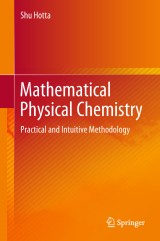Details

Mathematical Physical Chemistry
Practical and Intuitive Methodology|
CHF 260.00 |
|
| Verlag: | Springer |
| Format: | |
| Veröffentl.: | 23.01.2018 |
| ISBN/EAN: | 9789811076718 |
| Sprache: | englisch |
Dieses eBook enthält ein Wasserzeichen.
Beschreibungen
This book introduces basic concepts of mathematical physics to chemists. Many textbooks and monographs of mathematical physics may appear daunting to them. Unlike other, related books, however, this one contains a practical selection of material, particularly for graduate and undergraduate students majoring in chemistry. The book first describes quantum mechanics and electromagnetism, with the relation between the two being emphasized. Although quantum mechanics covers a broad field in modern physics, the author focuses on a hydrogen(like) atom and a harmonic oscillator with regard to the operator method. This approach helps chemists understand the basic concepts of quantum mechanics aided by their intuitive understanding without abstract argument, as chemists tend to think of natural phenomena and other factors intuitively rather than only logically. The study of light propagation, reflection, and transmission in dielectric media is of fundamental importance. This book explains theseprocesses on the basis of Maxwell equations. The latter half of the volume deals with mathematical physics in terms of vectors and their transformation in a vector space. Finally, as an example of chemical applications, quantum chemical treatment of methane is introduced, including a basic but essential explanation of Green functions and group theory. Methodology developed by the author will also prove to be useful to physicists. <div><br></div>
<div>1. Schrödinger Equation and Its Application.- 2. Quantum-Mechanical Harmonic Oscillator.- 3. Hydrogen-Like Atoms.- 4. Optical Transition and Selection Rules.- 5. Maxwell’s Equations.- 6. Reflection and Transmission of Electromagnetic Waves in Dielectric Media.- 7. Light Quanta: Radiation and Absorption.- 8. Introductory Green’s Functions.- 9. Vectors and Their Transformation.- 10. Canonical Forms of Matrices .- 11. Inner Product Space.- 12. Hermitian Operators and Unitary Operators.-13. Introductory Group Theory.-14. Symmetry Groups.-15. Representation Theory of Groups.-16. Applications of Group Theory to Physical Chemistry.</div><p></p><div><br></div><br>
Shu Hotta received his doctor of engineering degree at Kyoto University in 1988, while he was employed by Matsushita Electric Industrial Co., Ltd. (currently, Panasonic Corporation). His research interests cover development of novel organic semiconductors and their optoelectronic device applications. Since 2003, he was a professor of the Laboratory of Polymer Physics, Kyoto Institute of Technology (KIT). He had 12 years teaching experience at KIT. Now he is a Professor Emeritus, KIT. He contributed to 12 books and published 216 scientific articles in internationally renowned journals such as Advanced Materials and Physical Review B, etc. He won APEX/JJAP Editorial Contribution Award from The Japan Society of Applied Physics in 2014. <div><br></div>
This book introduces basic concepts of mathematical physics to chemists. Many textbooks and monographs of mathematical physics may appear daunting to them. Unlike other, related books, however, this one contains a practical selection of material, particularly for graduate and undergraduate students majoring in chemistry. The book first describes quantum mechanics and electromagnetism, with the relation between the two being emphasized. Although quantum mechanics covers a broad field in modern physics, the author focuses on a hydrogen(like) atom and a harmonic oscillator with regard to the operator method. This approach helps chemists understand the basic concepts of quantum mechanics aided by their intuitive understanding without abstract argument, as chemists tend to think of natural phenomena and other factors intuitively rather than only logically. The study of light propagation, reflection, and transmission in dielectric media is of fundamental importance. This book explains theseprocesses on the basis of Maxwell equations. The latter half of the volume deals with mathematical physics in terms of vectors and their transformation in a vector space. Finally, as an example of chemical applications, quantum chemical treatment of methane is introduced, including a basic but essential explanation of Green functions and group theory. Methodology developed by the author will also prove to be useful to physicists. <div><br></div>
Contains a judicious selection of material to help chemists understand the basic concepts of quantum mechanics and electromagnetism without abstract argument Shows how an operator method fits well with chemists' intuitive understanding Includes methodology that the author developed that will be useful to physicists

















